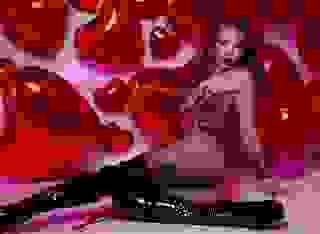- How To
- Flogging
Note: You can change font size, font face, and turn on dark mode by clicking the "A" icon tab in the Story Info Box.
You can temporarily switch back to a Classic Literotica® experience during our ongoing public Beta testing. Please consider leaving feedback on issues you experience or suggest improvements.
Click hereFlogging
The most important part of a flogger are the falls also called lashes, thongs, tresses, strands, etc. These falls are made of different materials, in different styles and with different ends or tips. Handle and knob designs are mostly a matter of personal taste as well as the maker's signature (especially in the knobs). But the falls make a very real difference in the sensation delivered by the flogger.
When applied to your subject most Floggers most fall somewhere between being thuddy or stingy. A thuddy flogger delivers a deep, pounding sensation. Used moderately, it can feel something like a massage. Stingy floggers deliver a much sharper sensation. Some people say they feel two sensations, one when the flogger hits, and another a second or two later. Which flogger you will want to use will depend on the effect you're after, as well as personal preferences. Practically every aspect of the falls contributes to how stingy or thuddy a flogger will feel.
Width: The wider the falls, the thuddier the sensation; thinner tails mean more sting.
Number: Fewer falls equals more sting; more tails equals more thud. The typical flogger has about 15 to 25 falls.
Points: Rounded and square-cut tips are the most gentle; pointed tips are stingy and forked points, doubly so.
Length & Weight: The longer the falls, the heavier they are and the faster the tips will be traveling when they hit their target. Heavier generally translates to thuddier, while faster can mean stingy. The exact effect will depend on the other factors controlling sting versus thud. About 16 to 24 inches is an average length for flogger falls.
Materials Besides the weight, width, length, and point cut, the fall's material matters most. There are a wide variety of leather and other materials available, and each provides a different sensation.
Chamois: The same thing you use to dry your car, chamois is buttery soft and very light. It's rare to find a flogger made out of this stuff, and with good reason: chamois will provide almost no sensation at all! You'll get some noise, a very light skin-level sensation, and not much else.
Plonge: A thin, lightweight, buttery soft cow hide, plonge has a shiny finish and a lush suede side. It is extremely gentle, although it can produce significant sting if used with force. Very few whip makers work in plonge.
Deerskin: A light and velvety hide, deerskin is great for caressing the body, and makes an excellent "warm-up" whip. Lots of noise, but very little impact.
Light Cowhide: Slightly stiffer and heavier than deerskin, light cowhide is used by some whip makers as an "in between" material. It generally has a light thuddy feel.
Elk: Heavier than deerskin, Elk is still fairly soft and compressible. It delivers almost pure thud, but gently so: you can put a lot of force behind a blow without risk of hurting someone.
Full Suede: A bit harder and stiffer than Elk. Mostly thuddy, but can sting a bit if the tips are flicked quickly. Many floggers are some sort of suede, and this is a very versatile and useful material for most players.
Top-Grain Cowhide: These leathers are smooth on one side, creating less friction with the air and more sting on impact. Whip makers seem to generally steer clear of these, perhaps because of the "mismatched" look of the tails.
Oil Tanned Leather: A soft, oily leather that tends to stretch...Mostly sting with a little thud. Moose: A dense and supple leather with a nice surface texture. Mostly thuddy, with some sting.
Buffalo or Bison: A thick, dense, yet soft leather with a very distinctive and defined grain. Very thuddy, but can sting if used correctly.
Bull hide: Heavier and less stretchy than buffalo, bull hide produces a lot of thud and some sting.
Latigo: A very dense and tough cowhide, heavily tanned. Latigo produces intense sting with very little effort.
Leather isn't the only material available for whip making. Some very interesting floggers have been made from non-traditional materials.
Rope: Unwind or unweave a rope, add a handle, and you have an interesting and versatile flogger. Widely frayed ends result in a very gentle toy; knotted ends can be more severe.
Horsehair: Horsehair floggers deliver the sensation of being scratched. This is one of the few floggers that grow less powerful as you make the fall thicker; more hair slows down the swing and reduces the impact.
Rubber: Most people will caution you that rubber whips are very severe. But it depends on the type and cut of rubber. The cardinal rule for rubber floggers is, "When in doubt, try it out."
Chain: Fine metal chain, or the ball chain used to turn on ceiling fans, is sometimes used to make floggers. Very intense, these should be used with great caution. Since they're made of metal and hold temperature well, they're more popular for dragging over the skin after being stored in a freezer than for actual floggings.
Posture/Stance The bottom can be positioned in various positions depending on the part of body to be flogged. Back or front to the top as they request, demand or negotiate. This ranges from standing, lying down, bent over, suspension hanging, kneeling, etc. Keep in mind that each posture can create a change in the way you can use a flogger on them.
There are many possible postures for the top, and you'll have to experiment to find one that's comfortable for you. Most important thing is that you strike as accurately as possible. The most common stance for flogging is a modified fencing stance or a martial arts "ready" stance. The legs are separated with the front of the body pointing to one side. The foot nearer to the bottom points toward the bottom, and the rear foot points to the side. The knees should be slightly bent, to facilitate easily crouching lower (to ease lower strikes) and side-to-side motion (to ease the use of different angles of impact). The ideal stance is a flexible one, as the top may want to move quickly from one position to another as the different strokes require. Good floggings often remind one of a dance.
Gripping the Flogger. Hold the flogger in your strong hand. Your grip should be firm but your wrist and arm must not be rigid, as a fluid motion assists in accuracy and control. Think of it as holding on to a small bird firm but not crushing. Experiment with the flogger to see where on the handle to grip. Holding the handle near the end will allow for more forceful blows, but may be more difficult to control for beginners. The flogger should feel well balanced, and it should swing with a minimum of effort. Good balance is one of the differences between a cheap flogger and a good flogger.
Fall of tails To determine the fall of your tails lightly swing your flogger in an underhand fashion straight out in front of you (palm down), and move forward or backwards until you see the tips just brush your target. This is the outside of your swing. You should extend your arm fully at this time to reach your target without leaning at all. Now...lean forward a bit until you can see the lashes fall a little flatter in the middle of your target. This is the inside of your swing. Any closer and you risk wrapping the tails around the side of your subjects’ body, which is very painful.
Brushing with the tip can cause a stingier/softer effect depending on the type of flogger used and the force behind the throw. When the lashes fall a little flatter it causes more contact and will produce more of a thuddy feeling.
Flogging Techniques/Tips Don't try and do all the work or fight against the flogger. Simplify the motion of the stroke as much as possible. Use the weight of momentum and the leverage of the arm/flogger combination as much as possible. In other words let the whip do the work. You can also lean forwards and backwards during the course of a stroke to put your weight into the stroke or to take some of it out.
If the falls of your flogger tend to splay out too much on impact you can slightly twist your hand halfway through the stroke to help bring the tails into line with each other. For a lighter stroke, you can slow the speed of the flogger as it reaches the top of its arc, and let the tails fall gently on the bottom.
Generally, the more directly the tips strike the bottom, the thuddier the sensation is. When the tips of the flogger’s falls brush against the bottom, and do so quickly, the sensation is often stingier.
The tips of the flogger, as they strike, convey the greatest force of the stroke. Thus, when one is flogging heavily, it is helpful to strike in such a way that the tips land first, this will also help avoid wrapping, which occurs when the middle of the tails strikes a good area, but the tips (which land later) wrap around to strike over the shoulder, around the torso, etc. This is generally considered Bad form. Also the tips speed up and wrapping can leave very interesting marks with a lighter flogger.
It's difficult to judge what strokes and floggers to use on a bottom at a particular time if you don't know the bottom very well or if you’re just starting out in flogging. The key is to ensure proper communication beforehand, and proper feedback verbal and non-verbal during the flogging (hence you might not want to use a gag when starting out or with someone new). But as with most things BDSM related. GO SLOW.
Flogging Strokes One basic stroke is the Overhand Stroke. It consists of striking overhand, with the palm toward the bottom. Throw the flogger back over the shoulder of the arm your holding the flogger in (be sure to grip the handle, don't want a flogger flying off behind you somewhere). Holding your elbow higher at this point can help increase the arc and speed of the flogger but isn't necessary. Now throw the flogger forward in an arcing motion by straightening your arm at the elbow and allowing the weight of the flogger to carry it down. This is a great motion to use to allow the tails to gently splay across the body. But if you increase the speed of your arm it can become a very powerful stroke. Another basic stroke is the forehand stroke. It's much like using a golf club. It consists of a side armed stoke with the palm toward the bottom. Starting with holding your arm out to the side and bring your arm across the front of your body. This naturally leads in to the next basic stroke.
The backhand stroke. This can consist of an overhand backhand stroke or a straight backhand stroke. The overhand backhand stroke consists of striking overhand with the palm towards you. With the flogger over the shoulder of the opposite arm your holding the flogger in. Throw the flogger forward in an arcing motion by straightening your arm at the elbow and allowing the weight of the flogger to carry it down. Keeping the elbow high will help increase the arc and speed of the flogger but personal preference should prevail.
The straight backhand stroke is very similar but instead of starting with the flogger over the opposite shoulder it merely starts out across the opposite side of the body your holding the flogger in. With the palm towards you straighten your elbow in the direction of your target and allow the tails to come around to the other side.
The underhand forehand and underhand backhand strokes are merely a variation of the forehand and backhand strokes. By starting with the flogger handle pointing down to begin with and bringing it up. These strokes take more skill and strength than those above and can require lots of practice to get them right.
The punching or flicking stroke, which may be overhand or backhand, but includes flipping the wrist to provide more of a sensation of the tails going straight into their target, rather than striking them obliquely. This is commonly perceived as thuddier than other strokes, and is valuable for providing a different sensation, as well as allowing strokes in body areas (especially lower ones) that might otherwise be difficult to strike. It is often easier to learn the punching stroke if you use your non-flogging hand as a guide for the flogger tails as they begin their motion.
The figure eight stroke is a combination of strokes on each pass. Forehand and backhand, overhand and overhand backhand, etc. You'll find it works your muscles more evenly and is a bit easier for longer flogging sessions...plus it has a certain fluidity and flair to it.
Start with a normal forehand stroke. As you come down towards your target, however, don't go straight down; instead, cross in front of yourself. Rather than bringing your flogger down along your right side, bring it down to your left (for the right handed person). Now swing up on the left and cross back; you'll find your palm naturally turns for a backhand shot. Swing down and back to the right, then repeat the eight.
This one will probably feel awkward at first. One key is not to travel back as far as you do for a forehand or backhand swing alone. Just let the flogger follow a gentle figure eight in front of you. With practice you'll find you can hit the same spot with the same intensity on both the forehand and backhand strokes.
As you're practicing the various strokes, keep an eye on the target and what's happening to it. Are you seeing marks that extend from the center around the edges, a clear sign of wrapped falls? Be careful to watch how your falls land and adjust accordingly.
While not exactly a stroke spinning or pin wheeling a flogger can provide a gentle breeze, a fast caressing touch, or a barrage of stings. The technique is simple: hold the flogger's handle firmly, and whirl the tails around in a tight circle using your wrist. At first you might find it easier to get the tails spinning, and then move them into contact with your target.
The line stroke is also a combination of strokes on each pass. Forehand to backhand (a side to side motion), and overhand to underhand (a up and down motion). In both, the stroke merely moves in a straight line from one stroke to the other.
The biggest concern here is just be careful and start out slowly.








